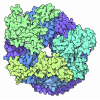+ Open data
Open data
- Basic information
Basic information
| Entry | Database: PDB / ID: 1ubq | ||||||
|---|---|---|---|---|---|---|---|
| Title | STRUCTURE OF UBIQUITIN REFINED AT 1.8 ANGSTROMS RESOLUTION | ||||||
 Components Components | UBIQUITIN | ||||||
 Keywords Keywords | CHROMOSOMAL PROTEIN | ||||||
| Function / homology |  Function and homology information Function and homology information: / : / protein modification process => GO:0036211 / Peptide chain elongation / Selenocysteine synthesis / Formation of a pool of free 40S subunits / Eukaryotic Translation Termination / Response of EIF2AK4 (GCN2) to amino acid deficiency / SRP-dependent cotranslational protein targeting to membrane / Viral mRNA Translation ...: / : / protein modification process => GO:0036211 / Peptide chain elongation / Selenocysteine synthesis / Formation of a pool of free 40S subunits / Eukaryotic Translation Termination / Response of EIF2AK4 (GCN2) to amino acid deficiency / SRP-dependent cotranslational protein targeting to membrane / Viral mRNA Translation / Nonsense Mediated Decay (NMD) independent of the Exon Junction Complex (EJC) / GTP hydrolysis and joining of the 60S ribosomal subunit / L13a-mediated translational silencing of Ceruloplasmin expression / Major pathway of rRNA processing in the nucleolus and cytosol / Nonsense Mediated Decay (NMD) enhanced by the Exon Junction Complex (EJC) / Maturation of protein E / Maturation of protein E / ER Quality Control Compartment (ERQC) / Myoclonic epilepsy of Lafora / FLT3 signaling by CBL mutants / Prevention of phagosomal-lysosomal fusion / IRAK2 mediated activation of TAK1 complex / Alpha-protein kinase 1 signaling pathway / Glycogen synthesis / IRAK1 recruits IKK complex / IRAK1 recruits IKK complex upon TLR7/8 or 9 stimulation / Endosomal Sorting Complex Required For Transport (ESCRT) / Membrane binding and targetting of GAG proteins / Negative regulation of FLT3 / Regulation of TBK1, IKKε (IKBKE)-mediated activation of IRF3, IRF7 / PTK6 Regulates RTKs and Their Effectors AKT1 and DOK1 / Regulation of TBK1, IKKε-mediated activation of IRF3, IRF7 upon TLR3 ligation / Constitutive Signaling by NOTCH1 HD Domain Mutants / IRAK2 mediated activation of TAK1 complex upon TLR7/8 or 9 stimulation / cytosolic ribosome / NOTCH2 Activation and Transmission of Signal to the Nucleus / TICAM1,TRAF6-dependent induction of TAK1 complex / TICAM1-dependent activation of IRF3/IRF7 / APC/C:Cdc20 mediated degradation of Cyclin B / Downregulation of ERBB4 signaling / Regulation of FZD by ubiquitination / APC-Cdc20 mediated degradation of Nek2A / p75NTR recruits signalling complexes / InlA-mediated entry of Listeria monocytogenes into host cells / TRAF6 mediated IRF7 activation in TLR7/8 or 9 signaling / TRAF6-mediated induction of TAK1 complex within TLR4 complex / Regulation of pyruvate metabolism / NF-kB is activated and signals survival / Regulation of innate immune responses to cytosolic DNA / Downregulation of ERBB2:ERBB3 signaling / Pexophagy / NRIF signals cell death from the nucleus / VLDLR internalisation and degradation / Regulation of PTEN localization / Activated NOTCH1 Transmits Signal to the Nucleus / Regulation of BACH1 activity / Synthesis of active ubiquitin: roles of E1 and E2 enzymes / MAP3K8 (TPL2)-dependent MAPK1/3 activation / TICAM1, RIP1-mediated IKK complex recruitment / Translesion synthesis by REV1 / InlB-mediated entry of Listeria monocytogenes into host cell / Translesion synthesis by POLK / Activation of IRF3, IRF7 mediated by TBK1, IKKε (IKBKE) / Downregulation of TGF-beta receptor signaling / JNK (c-Jun kinases) phosphorylation and activation mediated by activated human TAK1 / Josephin domain DUBs / Translesion synthesis by POLI / Regulation of activated PAK-2p34 by proteasome mediated degradation / IKK complex recruitment mediated by RIP1 / Gap-filling DNA repair synthesis and ligation in GG-NER / PINK1-PRKN Mediated Mitophagy / TGF-beta receptor signaling in EMT (epithelial to mesenchymal transition) / TNFR1-induced NF-kappa-B signaling pathway / Autodegradation of Cdh1 by Cdh1:APC/C / APC/C:Cdc20 mediated degradation of Securin / TCF dependent signaling in response to WNT / N-glycan trimming in the ER and Calnexin/Calreticulin cycle / Regulation of NF-kappa B signaling / Asymmetric localization of PCP proteins / Ubiquitin-dependent degradation of Cyclin D / activated TAK1 mediates p38 MAPK activation / SCF-beta-TrCP mediated degradation of Emi1 / NIK-->noncanonical NF-kB signaling / TNFR2 non-canonical NF-kB pathway / AUF1 (hnRNP D0) binds and destabilizes mRNA / Regulation of signaling by CBL / Vpu mediated degradation of CD4 / Negative regulators of DDX58/IFIH1 signaling / NOTCH3 Activation and Transmission of Signal to the Nucleus / Deactivation of the beta-catenin transactivating complex / Assembly of the pre-replicative complex / Ubiquitin-Mediated Degradation of Phosphorylated Cdc25A / Degradation of DVL / Negative regulation of FGFR3 signaling / Fanconi Anemia Pathway / Peroxisomal protein import / Dectin-1 mediated noncanonical NF-kB signaling / Cdc20:Phospho-APC/C mediated degradation of Cyclin A / Negative regulation of FGFR2 signaling / Stabilization of p53 Similarity search - Function | ||||||
| Biological species |  Homo sapiens (human) Homo sapiens (human) | ||||||
| Method |  X-RAY DIFFRACTION / Resolution: 1.8 Å X-RAY DIFFRACTION / Resolution: 1.8 Å | ||||||
 Authors Authors | Vijay-Kumar, S. / Bugg, C.E. / Cook, W.J. | ||||||
 Citation Citation |  Journal: J Mol Biol / Year: 1987 Journal: J Mol Biol / Year: 1987Title: Structure of ubiquitin refined at 1.8 A resolution. Abstract: The crystal structure of human erythrocytic ubiquitin has been refined at 1.8 A resolution using a restrained least-squares procedure. The crystallographic R-factor for the final model is 0.176. Bond ...The crystal structure of human erythrocytic ubiquitin has been refined at 1.8 A resolution using a restrained least-squares procedure. The crystallographic R-factor for the final model is 0.176. Bond lengths and bond angles in the molecule have root-mean-square deviations from ideal values of 0.016 A and 1.5 degrees, respectively. A total of 58 water molecules per molecule of ubiquitin are included in the final model. The last four residues in the molecule appear to have partial occupancy or large thermal motion. The overall structure of ubiquitin is extremely compact and tightly hydrogen-bonded; approximately 87% of the polypeptide chain is involved in hydrogen-bonded secondary structure. Prominent secondary structural features include three and one-half turns of alpha-helix, a short piece of 3(10)-helix, a mixed beta-sheet that contains five strands, and seven reverse turns. There is a marked hydrophobic core formed between the beta-sheet and alpha-helix. The molecule features a number of unusual secondary structural features, including a parallel G1 beta-bulge, two reverse Asx turns, and a symmetrical hydrogen-bonding region that involves the two helices and two of the reverse turns. #1:  Journal: J.Biol.Chem. / Year: 1987 Journal: J.Biol.Chem. / Year: 1987Title: Comparison of the Three-Dimensional Structures of Human, Yeast, and Oat Ubiquitin Authors: Vijay-Kumar, S. / Bugg, C.E. / Wilkinson, K.D. / Vierstra, R.D. / Hatfield, P.M. / Cook, W.J. #2:  Journal: Proc.Natl.Acad.Sci.USA / Year: 1985 Journal: Proc.Natl.Acad.Sci.USA / Year: 1985Title: Three-Dimensional Structure of Ubiquitin at 2.8 Angstroms Resolution Authors: Vijay-Kumar, S. / Bugg, C.E. / Wilkinson, K.D. / Cook, W.J. #3:  Journal: J.Mol.Biol. / Year: 1979 Journal: J.Mol.Biol. / Year: 1979Title: Crystallization and Preliminary X-Ray Investigation of Ubiquitin, a Non-Histone Chromosomal Protein Authors: Cook, W.J. / Suddath, F.L. / Bugg, C.E. / Goldstein, G. #4:  Journal: Nature / Year: 1975 Journal: Nature / Year: 1975Title: Molecular Conservation of 74 Amino Acid Sequence of Ubiquitin between Cattle and Man Authors: Schlesinger, D.H. / Goldstein, G. | ||||||
| History |
|
- Structure visualization
Structure visualization
| Structure viewer | Molecule:  Molmil Molmil Jmol/JSmol Jmol/JSmol |
|---|
- Downloads & links
Downloads & links
- Download
Download
| PDBx/mmCIF format |  1ubq.cif.gz 1ubq.cif.gz | 26.3 KB | Display |  PDBx/mmCIF format PDBx/mmCIF format |
|---|---|---|---|---|
| PDB format |  pdb1ubq.ent.gz pdb1ubq.ent.gz | 17.5 KB | Display |  PDB format PDB format |
| PDBx/mmJSON format |  1ubq.json.gz 1ubq.json.gz | Tree view |  PDBx/mmJSON format PDBx/mmJSON format | |
| Others |  Other downloads Other downloads |
-Validation report
| Summary document |  1ubq_validation.pdf.gz 1ubq_validation.pdf.gz | 414.3 KB | Display |  wwPDB validaton report wwPDB validaton report |
|---|---|---|---|---|
| Full document |  1ubq_full_validation.pdf.gz 1ubq_full_validation.pdf.gz | 416.1 KB | Display | |
| Data in XML |  1ubq_validation.xml.gz 1ubq_validation.xml.gz | 6.3 KB | Display | |
| Data in CIF |  1ubq_validation.cif.gz 1ubq_validation.cif.gz | 7.6 KB | Display | |
| Arichive directory |  https://data.pdbj.org/pub/pdb/validation_reports/ub/1ubq https://data.pdbj.org/pub/pdb/validation_reports/ub/1ubq ftp://data.pdbj.org/pub/pdb/validation_reports/ub/1ubq ftp://data.pdbj.org/pub/pdb/validation_reports/ub/1ubq | HTTPS FTP |
-Related structure data
| Similar structure data |
|---|
- Links
Links
- Assembly
Assembly
| Deposited unit | 
| ||||||||
|---|---|---|---|---|---|---|---|---|---|
| 1 |
| ||||||||
| Unit cell |
|
- Components
Components
| #1: Protein | Mass: 8576.831 Da / Num. of mol.: 1 Source method: isolated from a genetically manipulated source Source: (gene. exp.)  Homo sapiens (human) / References: UniProt: P62988, UniProt: P0CG48*PLUS Homo sapiens (human) / References: UniProt: P62988, UniProt: P0CG48*PLUS |
|---|---|
| #2: Water | ChemComp-HOH / |
-Experimental details
-Experiment
| Experiment | Method:  X-RAY DIFFRACTION X-RAY DIFFRACTION |
|---|
- Sample preparation
Sample preparation
| Crystal | Density Matthews: 1.83 Å3/Da / Density % sol: 32.94 % |
|---|---|
| Crystal grow | *PLUS Method: other / Details: Cook, W.J., (1979) J. Mol. Biol., 130, 353. |
-Data collection
| Radiation | Scattering type: x-ray |
|---|---|
| Radiation wavelength | Relative weight: 1 |
| Reflection | *PLUS Highest resolution: 1.8 Å / Lowest resolution: 6 Å / Num. all: 5750 / Num. obs: 5554 / Observed criterion σ(I): 2.5 / Num. measured all: 6029 |
- Processing
Processing
| Software | Name: PROLSQ / Classification: refinement | ||||||||||||
|---|---|---|---|---|---|---|---|---|---|---|---|---|---|
| Refinement | Rfactor obs: 0.176 / Highest resolution: 1.8 Å | ||||||||||||
| Refinement step | Cycle: LAST / Highest resolution: 1.8 Å
| ||||||||||||
| Refine LS restraints |
| ||||||||||||
| Refinement | *PLUS Lowest resolution: 6 Å / Num. reflection obs: 5554 / σ(I): 2.5 | ||||||||||||
| Solvent computation | *PLUS | ||||||||||||
| Displacement parameters | *PLUS |
 Movie
Movie Controller
Controller





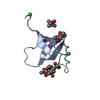


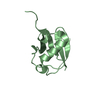
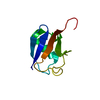


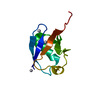
 PDBj
PDBj















